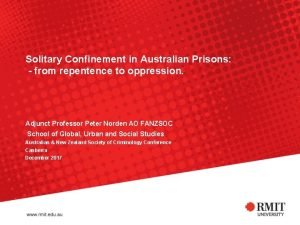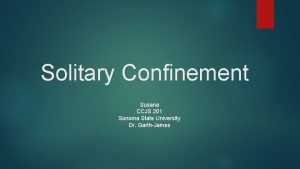SOLITARY CONFINEMENT IS INHUMANE Victoria Mc Kelvey What















- Slides: 15

SOLITARY CONFINEMENT IS INHUMANE Victoria Mc. Kelvey

What is Solitary Confinement? ■ Solitary Confinement is the isolation of a prisoner in a separate cell as a punishment. ■ Prisoners are kept in a 6 ft x 7 ft cell. There is a thin slot in the door to slide food through. ■ In isolation, prisoners are kept from all human contact. They cannot receive visits from anyone and are passed food from a trey through a thin slot in the door.


Doctor’s Visit ■ Dr. Dan Bannish, psychologist ■ Patient: Stephen Kirkley, 23 ■ Locked up for robbery and assault. ■ Kirkley received a puzzle. It was difficult to think outside of his cell and about his future because he is locked up and cannot see what’s on the outside. ■ He noticed in a few other cells that some inmates self harm and will cover their window with blood. Kirkley did this almost daily in hopes of receiving human contact during extraction.

Dr. Craig Haney, social psychologist ■ Back in 1993, Dr. Craig Haney interviewed some of the prisoners at Pelican Bay Penitentiary. He came back 20 years later to find some of the same prisoners. It is a “social death. ” ■ When he came back to the penitentiary he expected prisoners to have adjusted to life in a cell, but they did not. They are still depressed, anxious, etc. and had only worsened. ■ These prisoners grieve for their lost lives, loss of connections to the social world and families.

Against Our Human Nature ■ Neurobiologists call the brain an infovore (craves new information) as it constantly craves new information, which is difficult to impossible to do in solitary. ■ Humans have bigger brains in proportion to their body than other animals. There is a theory that the size of one’s brain is based on the size of their species’ social group. We are meant to be social beings, and segregation from other humans is unhealthy. Terry Anderson is an American citizen who was abducted in Lebanon. His concentration, literacy, avoiding hallucinations and emotions were all improved while being housed with other men, but while isolated his mind “disintegrated. ”

Prisoner’s Perception of Time ■ Prisoners in solitary confinement have less a perception of time. ■ Each cell has a single fluorescent light bulb dangling from the ceiling that never turns off. This makes it harder to perceive time.

PEOPL E

Joseph Harmon ■ Prisoners in segregation do not get many phone calls. Prisoner Joseph Harmon’s father passed away, so he was given a 15 minute phone call. He barely recognized his family member’s voices; he doesn’t know them anymore. ■ In an interview, prisoner of 8 years, Joseph Harmon explained to a psychologist, “If you put a parakeet in a cage for years and you take it out, it will die, so I stay in my cage. ” As much as prisoners want to leave, they feel overwhelmed with the outside world and not as comfortable being around so many people. ■ Another prisoner was given a family photo. He cut out their photos and placed them next to him as he watched TV. He says, “Maybe I’m crazy, but it makes me feel like I’m with them. ”

Thomas Silverstein

Thomas Silverstein ■ Age: 64 ■ He is in prison for an armed robbery at age 19. Killed 4 other inmates, as well as correction officer Clutts. He has been serving 29 years thus far and is in for life without parole. He resulted to more violent crimes after being in prison. ■ His behavior is unpredictable, but recently cleaning up his act. ■ He is currently filing a lawsuit against the Federal Bureau because he believes he has been mistreated and held in conditions that violate his rights in the constitution. He has kept a clean record for 22 years and wishes to serve the rest of his time in general population.

Albert Woodfox At age 68, Albert Woodfox was released from solitary confinement due to health reasons. It was unhealthy for him to be in segregation, and he had good behavior. He was locked up for 43 years for killing a prison guard.

Stephen Kirkley At age 23, Stephen Kirkley was in solitary confinement for robbery and assault. He occasionally went to general population for good behavior, but always came back because of misconduct. One year after he was released, he was placed back into solitary confinement. He had been psychologically effected in segregation, so he lost social skills and behaved out of character. He did not interact with other people correctly.

Adam Brulotte ■ Adam Bruoltte, age 21, was put in segregation for 18 months for aggravated assault, punching a kid 7 times in the jaw. His behavior other than that was not so violent, and he only had minor offenses. Only after he had been in segregation had he turned to more violent acts.

Sources Aryan Brotherhood - "Terrible" Tom. You. Tube. "Gangland": History Channel, 20 Oct. 2008. Web. 2 Mar. 2017. Boghani, Priyanka. "Locked Up In America: Stephen’s Story. " PBS. Frontline, 15 June 2015. Web. 02 Mar. 2017. Cohen, Andrew. "Creating Monsters: How Solitary Confinement Hurts the Rest of Us. "The Atlantic. Frontline, 18 Apr. 2014. Web. 02 Mar. 2017. Emily Lane. "Angola 3's Albert Woodfox Released Friday after Decades in Solitary. " NOLA. com. NOLA Media Group, 19 Feb. 2016. Web. 02 Mar. 2017. Germanos, Andrea. "Albert Woodfox Free: Last of Angola 3, Who Spent Decades in Solitary, Released. " Common Dreams, 19 Feb. 2016. Web. 02 Mar. 2017. Goode, Erica. "Solitary Confinement: Punished for Life. " The New York Times, 03 Aug. 2015. Web. 02 Mar. 2017. "John Mc. Cain Presidential Campaign, 2008. " Wikipedia, 22 Feb. 2017. Web. 02 Mar. 2017. "Locked Up in America. " PBS. Public Broadcasting Service, n. d. Web. 02 Mar. 2017. "Thomas Silverstein. " Wikipedia, 28 Jan. 2017. Web. 02 Mar. 2017. Waggoner, Martha. "Former AP Reporter and Hostage Terry Anderson Discusses Journalists’ Kidnappings. " News Media Guild Newa, 15 Mar. 2015. Web. 02 Mar. 2017.
 Thomas silverstein
Thomas silverstein Solitary confinement effects
Solitary confinement effects Centros alternativos de los 7 habitos
Centros alternativos de los 7 habitos Inertial confinement
Inertial confinement Projet enseignement scientifique première
Projet enseignement scientifique première Inertial confinement
Inertial confinement Inertial confinement fusion lasers
Inertial confinement fusion lasers Confinement principle in computer system security
Confinement principle in computer system security Confinement qcd
Confinement qcd Solitary as an oyster pee paragraph
Solitary as an oyster pee paragraph Solitary independent play
Solitary independent play Verticillaster inflorescence diagram
Verticillaster inflorescence diagram Glickman classification
Glickman classification Who has composed the poem the solitary reaper
Who has composed the poem the solitary reaper Solitary work
Solitary work Solitary as an oyster pee paragraph
Solitary as an oyster pee paragraph



























